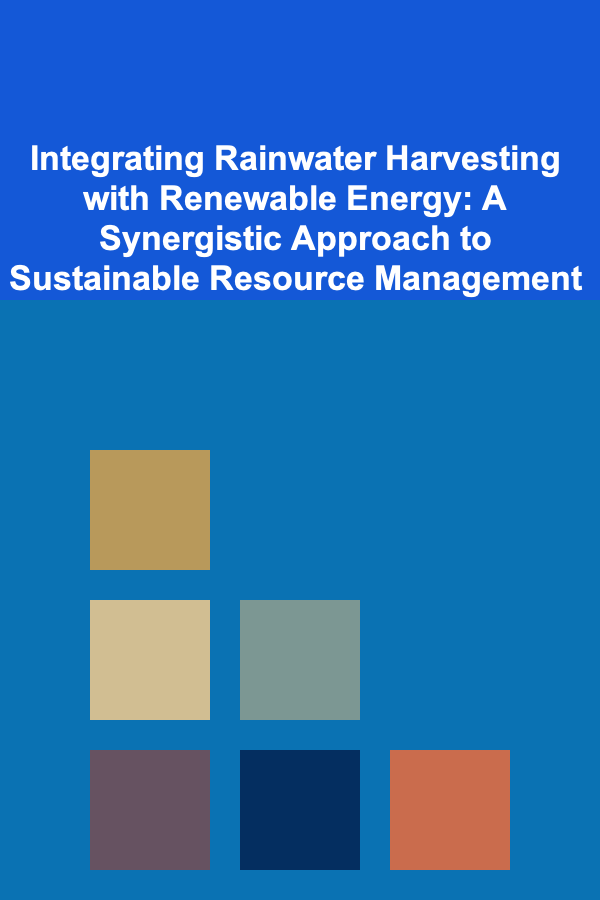
Integrating Rainwater Harvesting with Renewable Energy: A Synergistic Approach to Sustainable Resource Management
ebook include PDF & Audio bundle (Micro Guide)
$12.99$9.99
Limited Time Offer! Order within the next:

The escalating global challenges of water scarcity, energy security, and climate change demand innovative and integrated solutions. Rainwater harvesting (RWH) and renewable energy sources, particularly solar and wind, represent independently valuable strategies for addressing these challenges. However, the true potential lies in their synergistic integration. This article delves into the rationale, methodologies, and benefits of combining RWH with renewable energy, exploring how such a combined approach can significantly enhance sustainability, resilience, and resource efficiency.
The Imperative for Integrated Resource Management
Traditional approaches to resource management often treat water and energy as distinct entities. This siloed approach overlooks the inherent interdependencies between these crucial resources. Water is essential for energy production (e.g., cooling power plants, hydropower), while energy is required for water extraction, treatment, and distribution. This "water-energy nexus" highlights the need for holistic strategies that consider the interconnectedness of these systems.
Climate change exacerbates these interdependencies. Altered precipitation patterns, increased temperatures, and more frequent extreme weather events threaten both water and energy supplies. In many regions, drought conditions limit hydropower generation and increase the reliance on energy-intensive water desalination. Conversely, excessive rainfall and flooding can disrupt energy infrastructure and contaminate water sources. Integrating RWH and renewable energy offers a pathway to mitigate these vulnerabilities and enhance resilience in the face of climate change.
Understanding Rainwater Harvesting
Rainwater harvesting (RWH) is the process of collecting and storing rainwater for later use. It's a time-honored practice, dating back millennia, but it's experiencing a resurgence in popularity due to growing water stress and increasing awareness of its environmental and economic benefits. RWH systems can range from simple household setups involving a barrel to collect water from a downspout, to large-scale commercial or municipal systems that harvest rainwater from rooftops, paved surfaces, and open areas.
Types of Rainwater Harvesting Systems
- Rooftop Harvesting: This is the most common type of RWH, particularly for residential and commercial buildings. Rainwater is collected from rooftops and directed into storage tanks via gutters and downspouts. The water can be used for non-potable purposes such as irrigation, toilet flushing, and laundry.
- Surface Runoff Harvesting: This method involves collecting rainwater that flows over land surfaces, such as roads, parking lots, and agricultural fields. Surface runoff is often directed into ponds, reservoirs, or infiltration basins. It requires careful design and management to mitigate contamination risks.
- Groundwater Recharge: RWH can be used to replenish groundwater aquifers by directing rainwater into infiltration basins or wells. This helps to increase groundwater levels, reduce land subsidence, and improve water quality.
Benefits of Rainwater Harvesting
RWH offers a multitude of benefits, including:
- Reduced Water Demand: RWH can significantly reduce reliance on municipal water supplies, particularly for non-potable uses.
- Lower Water Bills: By using harvested rainwater, homeowners and businesses can lower their water bills.
- Reduced Stormwater Runoff: RWH can help to reduce stormwater runoff, which can overwhelm drainage systems and contribute to flooding and pollution.
- Improved Water Quality: Rainwater is naturally soft and free of chlorine and other chemicals commonly found in municipal water supplies.
- Enhanced Water Security: RWH provides a local, independent source of water, which can be particularly valuable during droughts or emergencies.
- Environmental Benefits: RWH reduces the energy required to extract, treat, and distribute water.
Renewable Energy: Powering a Sustainable Future
Renewable energy sources, such as solar, wind, hydro, and geothermal, offer a clean and sustainable alternative to fossil fuels. These resources are abundant and replenish naturally, making them a cornerstone of a sustainable energy future. Integrating renewable energy with RWH further enhances the sustainability of both systems and unlocks new opportunities for resource efficiency.
Key Renewable Energy Technologies
- Solar Photovoltaics (PV): Solar PV panels convert sunlight directly into electricity. They can be used to power RWH systems, such as pumps for water distribution and treatment.
- Solar Thermal: Solar thermal systems use sunlight to heat water or air. This can be used for domestic hot water heating, space heating, and industrial processes, reducing the energy demand on the grid.
- Wind Energy: Wind turbines convert wind energy into electricity. They can be used to power large-scale RWH systems or provide electricity for communities that rely on RWH for their water supply.
- Hydropower: Hydropower uses the energy of moving water to generate electricity. While often large scale, micro-hydro systems can be used in conjunction with RWH systems to power pumps and other equipment.
Benefits of Renewable Energy
Renewable energy provides numerous advantages:
- Reduced Greenhouse Gas Emissions: Renewable energy sources produce little or no greenhouse gas emissions, helping to mitigate climate change.
- Reduced Air Pollution: Renewable energy reduces air pollution, improving public health.
- Energy Security: Renewable energy reduces reliance on imported fossil fuels, enhancing energy security.
- Job Creation: The renewable energy industry is a growing sector that creates new jobs.
- Sustainable Resource Management: Renewable energy uses resources that replenish naturally, making it a sustainable source of energy.
Integrating Rainwater Harvesting and Renewable Energy: Synergistic Opportunities
The true potential of RWH and renewable energy lies in their integration. This integration can take many forms, but the underlying principle is to use renewable energy to power and enhance RWH systems, while RWH provides a resilient and sustainable water source. This creates a virtuous cycle, where each system supports and strengthens the other.
Applications of Integrated RWH and Renewable Energy
- Solar-Powered Water Pumping: Solar PV panels can be used to power pumps that distribute harvested rainwater from storage tanks to various end-use points. This eliminates the need for grid electricity, reducing operating costs and carbon emissions. This is particularly valuable in off-grid or remote locations.
- Solar-Powered Water Treatment: Rainwater may require treatment before it can be used for certain purposes, such as drinking. Solar PV can power water treatment systems, such as UV disinfection units or filtration systems, providing a clean and sustainable water supply. Solar thermal can also be used for distillation.
- Wind-Powered Water Pumping and Treatment: Wind turbines can be used to power large-scale RWH systems, such as those used for irrigation or industrial processes. The electricity generated by the wind turbine can be used to power pumps, treatment systems, and other equipment.
- Micro-Hydro Powered RWH Systems: In situations where RWH systems involve diverting water flow, micro-hydro turbines can be implemented to generate electricity from that diverted flow, powering pumps or other RWH infrastructure.
- Combined Heat and Power (CHP) Systems for Water Heating: Biomass or solar thermal CHP systems can provide both electricity and heat. The electricity can be used to power RWH pumps and treatment systems, while the heat can be used to preheat water for domestic hot water or industrial processes, reducing the energy demand on the grid. This increases overall system efficiency.
- Energy Storage for RWH Systems: Integrating battery storage with solar PV or wind turbines can provide a reliable power supply for RWH systems, even when the sun isn't shining or the wind isn't blowing. This ensures that the RWH system can operate continuously, regardless of weather conditions. Excess renewable energy can be stored in batteries for later use, maximizing the efficiency of the system.
- Smart Grids and RWH Optimization: Connecting RWH systems to smart grids allows for better coordination and optimization of water and energy resources. Smart grids can monitor water levels in storage tanks and adjust pumping schedules to match the availability of renewable energy. This can help to reduce energy consumption and improve the overall efficiency of the RWH system. Demand response programs can incentivize RWH system operators to reduce their energy consumption during peak demand periods.
- Water Heating from RWH run-off using geothermal systems: Using collected rainwater as a source fluid for ground source heat pumps. The captured rainwater is pumped through a closed loop geothermal system, increasing the source fluid temperature, ultimately, decreasing electricity usage for heating.
Case Studies and Examples
Several successful projects demonstrate the feasibility and benefits of integrating RWH and renewable energy:
- The Bullitt Center, Seattle, WA: This six-story office building is designed to be a net-zero energy and water building. It features a large rooftop rainwater harvesting system that collects rainwater for all non-potable uses. Solar PV panels on the roof generate enough electricity to power the building, including the RWH system.
- The Khoo Teck Puat Hospital, Singapore: This hospital features a large-scale rainwater harvesting system that collects rainwater for irrigation and toilet flushing. Solar panels on the roof generate electricity to power the hospital, including the RWH system.
- Villages in Rural India: Many villages facing water scarcity have implemented integrated RWH and solar-powered pumping systems. These systems provide a reliable source of water for drinking and irrigation, improving the livelihoods of local communities.
- Commercial Buildings in Australia: Numerous commercial buildings are using rainwater harvesting systems powered by wind and solar energies to supply water for toilets, cooling towers, and gardening to decrease the need for city water.
Design Considerations for Integrated Systems
Designing an effective integrated RWH and renewable energy system requires careful consideration of several factors:
- Water Demand Analysis: The first step is to determine the water demand of the building or community that will be served by the RWH system. This includes estimating the water demand for different end-uses, such as irrigation, toilet flushing, and laundry.
- Rainfall Data Analysis: It's essential to analyze historical rainfall data to determine the average rainfall in the area and the variability of rainfall patterns. This information is used to estimate the amount of rainwater that can be harvested.
- Roof Area and Collection Efficiency: The roof area available for rainwater harvesting determines the potential amount of rainwater that can be collected. The collection efficiency of the roof surface and the gutter system also needs to be considered.
- Storage Tank Size: The size of the storage tank is crucial for ensuring that enough water is available to meet demand during dry periods. The storage tank size should be based on the water demand analysis, the rainfall data analysis, and the desired level of reliability.
- Renewable Energy System Sizing: The size of the renewable energy system should be based on the energy demand of the RWH system, including the power requirements of pumps, treatment systems, and other equipment. The availability of renewable energy resources, such as solar radiation and wind speed, also needs to be considered.
- System Integration and Control: The RWH system and the renewable energy system should be integrated in a way that optimizes the use of both resources. This may involve using smart controls to monitor water levels in storage tanks and adjust pumping schedules to match the availability of renewable energy.
- Water Quality Considerations: Rainwater can be contaminated by dust, debris, and other pollutants. The RWH system should include appropriate filtration and treatment systems to ensure that the water is safe for its intended use.
- Cost-Benefit Analysis: A cost-benefit analysis should be conducted to evaluate the economic feasibility of the integrated RWH and renewable energy system. This should include considering the initial costs of the system, the operating costs, and the potential savings in water and energy bills.
- Regulatory Compliance: RWH systems and renewable energy systems are subject to various regulations, depending on the location. It's important to ensure that the system complies with all applicable regulations.
- Geographic and Climatic Considerations: Regions with higher rainfall are more likely to benefit from rainwater harvesting. Whereas locations with higher solar irradiance are better fits for solar powered systems.
Challenges and Barriers
Despite the numerous benefits of integrating RWH and renewable energy, several challenges and barriers can hinder their widespread adoption:
- High Initial Costs: The initial costs of installing RWH systems and renewable energy systems can be high, particularly for large-scale systems.
- Lack of Awareness and Information: Many people are not aware of the benefits of integrating RWH and renewable energy. There is a need for more education and outreach to promote the adoption of these technologies.
- Regulatory Barriers: In some areas, regulations may restrict or discourage the use of RWH systems or renewable energy.
- Lack of Technical Expertise: Designing and installing integrated RWH and renewable energy systems requires specialized technical expertise.
- Maintenance Requirements: RWH systems and renewable energy systems require regular maintenance to ensure that they operate efficiently.
- Perceived Complexity: Some individuals view combining RWH and renewable energy as complicated, especially regarding system design and maintenance.
Overcoming the Barriers and Fostering Adoption
To overcome these barriers and foster the widespread adoption of integrated RWH and renewable energy systems, the following actions are needed:
- Government Incentives and Subsidies: Governments can provide financial incentives, such as tax credits and rebates, to encourage the adoption of RWH systems and renewable energy.
- Public Awareness Campaigns: Public awareness campaigns can educate people about the benefits of integrating RWH and renewable energy and promote the adoption of these technologies.
- Streamlined Regulations: Governments can streamline regulations to make it easier to install RWH systems and renewable energy systems.
- Training and Education Programs: Training and education programs can provide individuals with the technical expertise needed to design, install, and maintain integrated RWH and renewable energy systems.
- Development of Standards and Guidelines: The development of standards and guidelines can ensure that RWH systems and renewable energy systems are designed and installed safely and effectively.
- Community-Based Projects: Community-based projects can demonstrate the benefits of integrating RWH and renewable energy and encourage other communities to adopt these technologies.
- Technological Innovation: Continued innovation in RWH and renewable energy technologies can reduce costs and improve performance, making these systems more attractive to potential users.
- Promote modular and scalable solutions: Develop systems that are easily expanded or adapted as needs change, lowering initial investment risks.
The Future of Integrated Resource Management
Integrating rainwater harvesting with renewable energy represents a promising pathway towards sustainable resource management. As water scarcity intensifies and the transition to a clean energy economy accelerates, the adoption of these integrated systems will become increasingly critical. By embracing a holistic approach that considers the interconnectedness of water and energy, we can create more resilient, sustainable, and equitable communities for generations to come.
The future of integrated resource management lies in:
- Smart and Adaptive Systems: Developing smart systems that can adapt to changing weather conditions and water demand patterns. These systems will use sensors, data analytics, and artificial intelligence to optimize the use of water and energy resources.
- Decentralized and Distributed Systems: Promoting the development of decentralized and distributed RWH and renewable energy systems. This will reduce reliance on centralized infrastructure and enhance resilience.
- Community-Based Ownership and Management: Encouraging community-based ownership and management of RWH and renewable energy systems. This will empower communities to take control of their own resources and promote local economic development.
- Policy Integration: Integrating water and energy policies to create a more coherent and supportive regulatory environment for integrated resource management.
- Interdisciplinary Collaboration: Fostering collaboration between engineers, planners, policymakers, and community members to develop innovative and effective solutions.
Conclusion
The integration of rainwater harvesting and renewable energy is not just a technological solution; it is a fundamental shift in our approach to resource management. It necessitates a move away from siloed thinking towards a holistic perspective that recognizes the inherent interdependencies between water and energy. By embracing this integrated approach, we can unlock new opportunities for sustainability, resilience, and resource efficiency, paving the way for a more secure and prosperous future.

How to Keep Your Home's Exterior in Top Shape Year-Round
Read More
How to Use Acoustic Panels to Enhance Soundproofing at Home
Read More
Mastering the Art of Branding: A Consultant's Guide to Transformative Business Growth
Read More
How To Discover the Pyramids of Giza
Read More
Budgeting for the Unexpected: A Comprehensive Guide
Read More
How to Edit Gaming Videos for YouTube Success
Read MoreOther Products

How to Keep Your Home's Exterior in Top Shape Year-Round
Read More
How to Use Acoustic Panels to Enhance Soundproofing at Home
Read More
Mastering the Art of Branding: A Consultant's Guide to Transformative Business Growth
Read More
How To Discover the Pyramids of Giza
Read More
Budgeting for the Unexpected: A Comprehensive Guide
Read More